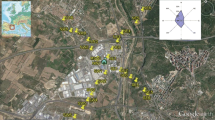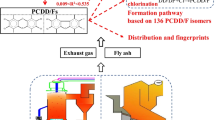Abstract
Dioxins and their surrogates were continuously monitored during the startup of two municipal waste in cinerators (MWIs). The surrogates studied included low-volatility organohalogen compounds (LVOH) sampled by online systems, as well as chlorobenzenes (CBs) and chlorophenols (CPs). The changes in levels of LVOH, CBs, and CPs corresponded well with the trend of the toxicity equivalent quantity (TEQ). The correlation of LVOH with TEQ was fairly good, whereas that of CBs and CPs with TEQ was not consistent. The correlation of LVOH with TEQ involved a memory effect related to the delayed emission of less volatile compounds. The isomer analysis of the dioxins present under startup conditions showed evidence of the memory effect, i.e., highly chlorinated isomers were emitted slowly, whereas low-chlorinated isomers and LVOH decreased rapidly as the temperature rose. LVOH cannot act as a perfect dioxin surrogate, but it can give a versatile, quick, and comprehensive warning of the presence of organohalogen compounds because it is free from the memory effect and covers many kinds of organohalogen compounds, including dioxins.
Similar content being viewed by others
References
Nordsieck HO, Neuer-Etscheidt K, Orasche J, Zimmermann R (2004) Changes in PCDD/PCDF formation process during instationary phases of combustor operation. Organohal Comp 66:1153–1159
Tejima H, Nishigaki M, Fujita Y, Matsumoto A, Takeda N, Takaoka M (2007) Characteristics of dioxin emissions at startup and shutdown of MSW incinerators. Chemosphere 66:1123–1130
Lee CW, Tabor DG, Cowen KA (2008) Environmental technology verification (ETV) test of dioxin emission monitors. J Mater Cycles Waste Manag 10:38–45
Oeberg T, Neuer-Etscheidt K, Nordsieck H, Zimmermann R (2002) Dioxin surrogates — a comparison of approaches. Organohal Comp 59; 37–44. (Revised version with a corrected reference list is available at http://www.tomasoberg.com/pdf/surrogates.pdf)
Lemieux PM (2004) The use of surrogate compounds as indicators of PCDD/F concentrations in combustor stack gases. EPA-600/R-04-024
US Environmental Protection Agency (2007) Environmental technology verification program, dioxin emission monitoring system. Available at: http://www.epa.gov/etv/pubs/600s07002.pdf
Blumenstock M, Kettrup A, Zimmermann R, Schramm K-W (2001) Identification of surrogate compounds for the emission of PCDD/F (I-TEQ value) and evaluation of their on-line real-time detectability in flue gases of waste incineration plants by REMPITOFMS mass spectrometry. Chemosphere 42:507–518
Yamada M, Waki I, Sakairi M, Sakamoto M, Imai T (2002) Realtime monitoring of dioxin precursors by APCI-ITMS: control of catalyst injection. Organohal Comp 59:65–68
Watanabe I, Kudo M, Kurata Y, Yamasaki K, Terashima C, Ikeguchi T (2002) Analysis of chlorophenols in flue gas of waste incinerators by HPLC/ECD installed sequential automated monitoring instrument as well as by HPLC/MS and GC/MS. Organohal Comp 59:89–92
Kato M, Urano K, Tasaki T (2000) Development of semi- and nonvolatile organic halogen as a new hazardous index of flue gas. Environ Sci Technol 34:4071–4075
Kawamoto K, Imaizumi T, Fujiyoshi H, Tanaka M (2002) Application of concentration of organohalogen compounds in flue gas for the management of dioxins. Organohal Comp 59:53–56
Watanabe N, Takakura A, Minami Y, Mizutani S, Takatsuki H (2007) Correlation of low-volatile organic chlorine (LVOCl) and PCDD/Fs in various municipal waste incinerators (MWIs). Chemosphere 67:S198–S204
Weber R (2005) On-line PCDD/PCDF and PCDD/PCDF surrogate monitoring. Basic difficulties due to formation characteristics, memory effects and removal efficiency of air pollution control devices. Organohal Comp 67:321–325
Japanese Industrial Standards Committee (2005) Method for determination of tetra- through octachlorodibenzo-p-dioxins, tetra- through octachlorodibenzofurans and dioxin-like polychlorinated biphenyls in stationary source emissions. JIS K0311
Watanabe N, Takakura A, Nakui H, Watanabe G, Sun I (2007) A study on the pretreatment of gas sampling for adsorption/thermal desorption analysis (in Japanese). J Environ Chem 17:461–469
Watanabe N, Minami Y, Mizutani S, Takatsuki H (2004) Collection efficiency and determination equivalency on the measurement of semi and low volatile organic chlorine (SLVOCl) in flue gas (in Japanese). J Environ Chem 14:597–604
Takakura A, Nakui H, Koyama H, Watanabe G, Watanabe N (2007) Study on sampling of organic halogenated compounds in flue gas (in Japanese). In: Proceedings of the 18th Annual Conference of The Japan Society of Waste Management Experts. Tsukuba, Japan, pp 588–590, Nov 19–21, 2007
Addink R, Olie K (1995) Mechanism of formation and destruction of polychlorinated dibenzo-p-dioxins and dibenzofurans in heterogeneous systems. Environ Sci Technol 29:1425–1435
Huang H, Bueckens A (1995) On the mechanism of dioxin formation in combustion processes. Chemosphere 31:4099–4117
Tuppurainen K, Halonen I, Ruokojärvi P, Tarhanen J, Ruuskanen J (1998) Formation of PCDDs and PCDFs in municipal waste incineration and its inhibition mechanisms: a review. Chemosphere 36:1493–1511
Hunsinger H, Jay K, Vehlow J (2002) Formation and destruction of PCDD/F inside a grate furnace. Chemosphere 46:1263–1272
Öberg T, Öhrström T (2003) Chlorinated aromatics from combustion: influence of chlorine, combustion conditions, and catalytic activity. Environ Sci Technol 37:3995–4000
Author information
Authors and Affiliations
Corresponding author
Rights and permissions
About this article
Cite this article
Watanabe, N., Kawamoto, K., Asada, S. et al. Surrogate study for dioxins from municipal waste incinerator in startup condition: applicability as a dioxin control indicator and an organohalogen emission warning. J Mater Cycles Waste Manag 12, 254–263 (2010). https://doi.org/10.1007/s10163-010-0295-8
Received:
Accepted:
Published:
Issue Date:
DOI: https://doi.org/10.1007/s10163-010-0295-8




